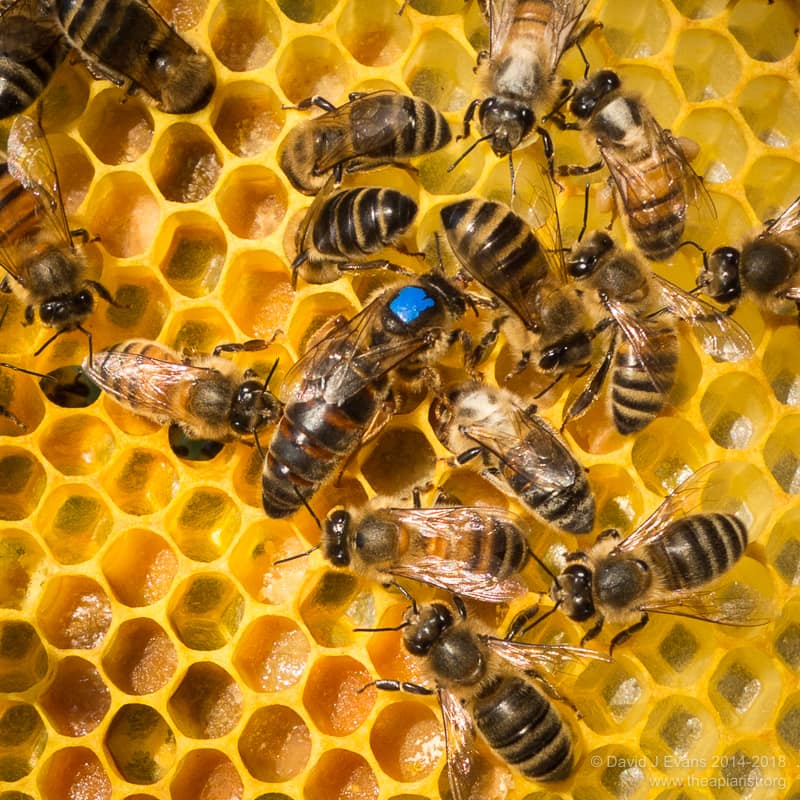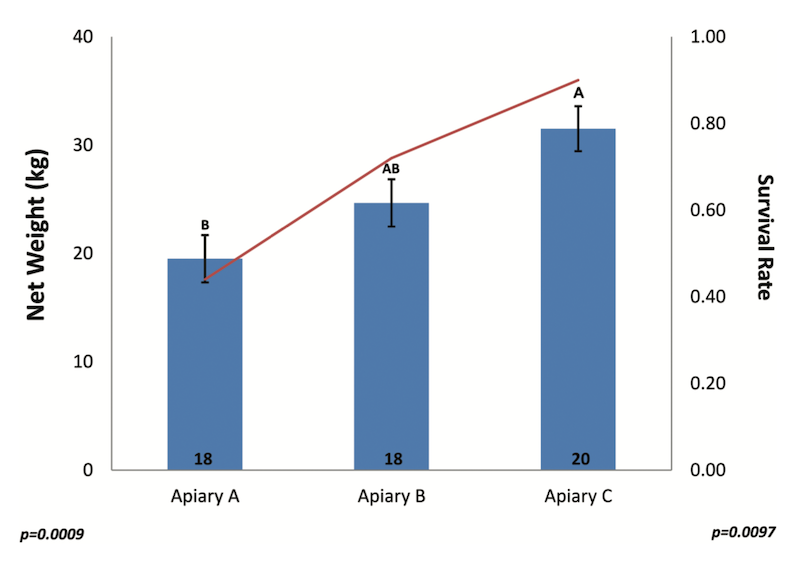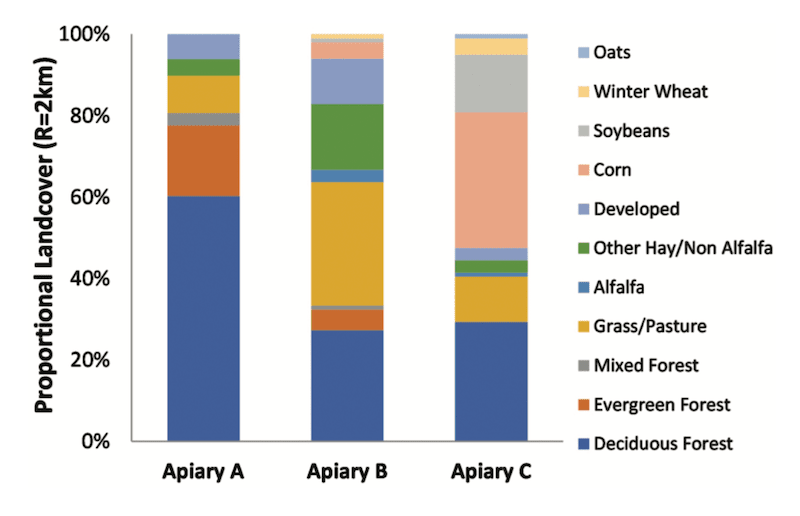Strong hives = live hives
Science and beekeeping make for interesting contrasts and can be awkward bedfellows {{1}}.
Science is based upon observation of tested single variables. multiple repeats and statistical analysis. It builds on what has gone before but has accepted processes to challenge well-established theories. Some of the greatest advances are made by young researchers willing to test – and subsequently overturn – established dogma.
Over the last three generations science – both how we do it and what we understand – has changed almost beyond recognition.
In contrast, beekeeping is steeped in history, has multiple variables – climate, forage, ability – and very small sample sizes. It tends to be taught by the most experienced, passing down established – though often not rigorously tested 🙁 – methods {{2}}.
As a consequence our beekeeping has barely changed over the last three decades. Established dogma tends to stay established.
Local bees are better adapted to local conditions
So let’s look in a little more detail at one of these established ‘facts’ … that locally reared bees are better adapted to local conditions.
The suggestion here is that locally reared bees, because they’re ‘better adapted’ (whatever that means) are more likely to flourish when the going is good, and more likely to survive when the going gets tough.
Furthermore, the implication is that they’re more likely to do better in that environment than bees reared elsewhere (and that are therefore adapted to a different environment).
This sounds like common sense.
As Brexit looms and the never-ending supply of early-season Greek or Slovenian queens disappears perhaps it’s also fortunate, rather than just being common sense.
But, as a scientist, I’ve spent a career questioning things.
Every time I read the “locally adapted bees survive better (or perform better, or whatever better)” {{3}} two questions pop into my head …
- What’s local?
- How did they prove – or how would I test – this?
Spoiler alert
There is evidence that local bees show adaptive changes to their local environment. There is also evidence that local bees do better in their local environment.
Formally, I don’t think scientists have demonstrated that the former explains the latter. This might seem trivial, but it does mean that our understanding is still incomplete.
However, I’m not going to discuss any of these things today – but I will in the future.
Instead I’m going to deal with those two questions that pop into my head.
If we tackle those I think we’ll be better placed to address that dogmatic statement that local bees are better adapted to local conditions in due course.
But perhaps we’ll first discover that other things are more important?
What’s local?
I live most of the time in central Fife. It’s a reasonably dry, relatively cool, largely arable part of the UK with a beekeeping season that lasts about 5 months (from first to last inspections).
Are my (fabulous 😉 ) locally bred queens adapted for central Fife, or the east of Scotland, or perhaps north-west maritime Europe, or Europe?
Would these locally adapted bees do better here (in Fife) than bees raised in the foothills of the Cairngorms, or the Midlands, or Devon or East Anglia … or Portugal?
If you measure the environment you’ll find there’s significant overlap in terms of the climate, the temperature, the forage, the day length (or a hundred other determinants) with other regions of the UK.
The temperature or rainfall extremes we experience in central Fife aren’t significantly different to those in the Midlands. The season duration is different (because of latitude), but I had lots of short seasons in the Midlands due to cool springs and early autumns.
Local is an ill-defined and subjective term.
But there are differences of course. Are Ardnamurchan bees better able to cope with the rain (and the fantastic scenery) than Fife bees? Are Fife bees better able to exploit arable crops than those foraging on the heather and Atlantic rainforests that cloak the hills in the far west of Scotland?
I don’t know 🙁
And there’s something else I don’t know
I also don’t know how I would meaningfully test this.
Just thinking about these types of experiments makes me nervous. Think of the year to year variation – in weather, forage etc. – compounded by the hive to hive variation.
Then multiply that by the variation between beekeepers.
This last one is a biggy. Two beekeepers of differing abilities will experience very different levels of success – quantified in terms of honey yield or hives that survive for example – in the same season and environment.
Doing a study large enough to be statistically relevant without having such enormous variation that the results are essentially meaningless is tricky.
What a nightmare.
Which, in a roundabout way, brings me to a paper earlier this year by Maryann Frazier and Christina Grozinger from Penn State University.
Ask the question in a different way
The title of the paper tells you most of what you need to know about the study.
Colony size, rather than geographic origin of stocks, predicts overwintering success in honey bees (Hymenoptera: Apidae) in the northeastern United States. {{4}}
But don’t stop reading … let’s look in a bit more detail at what they did.
They approached the question (that local bees are better adapted) from a slightly different angle.
Essentially the question they asked was “Does the geographic origin of the bees influence the overwintering survival of bees in a temperate region?”
This question is easier to answer.
They defined the parameters of the experiment a bit more clearly. For example:
- Rather than looking at several regions they just studied bees in one area – Pennsylvania (the temperate region in the title of the paper).
- The bees came from four sources; two were from a hot geographic region of the USA and two from a cold region.
- They scored ‘doing better’ only in terms of overwintering survival.
By simplifying the question they could reduce some of the variables. They could therefore increase the quantification of the parameters (colony weight, strength/size etc.) that might influence the ‘doing better’.
And in doing so, they came up with an answer.
The study
Sixty colonies were established in three apiaries in Pennsylvania. Two of the apiaries (A & B) were within 1 mile of each other, with the third (C) about 15 miles away. Colonies were generally established from packages {{5}}, to which a queen was introduced from one of four different queen breeders.
Two of the queen breeders were from southern USA (Texas or Florida) and two from northern USA (Vermont and West Virginia {{6}}.
The authors used microsatellite analysis to confirm that the queens – after introduction – headed genetically distinct colonies by midsummer {{7}}.
So far, so good …
They then used standard beekeeping methods to manage the colonies – regular inspections, Varroa treatments as appropriate, feeding them up for winter etc.
They scored colonies for a variety of ‘parameters’; net weight, frames of brood, adult bees and stores.
Four queens failed before winter.
And then they overwintered the remaining 56 colonies …
The results
… of which only 39 survived until April 🙁
39/56 sounds a pretty catastrophic loss to me but it’s actually about the same (~30%) as the average winter losses reported each year in the USA.
So, did the ‘cold-adapted’ {{8}} Vermont queens survive and prosper? Did the ‘Southern Belles’ {{9}} from Texas all perish in the cold Pennsylvanian winter?
No.
That’s no to both questions.
There was no significant difference in survival of colonies headed by queens from the north or the south.
The geographic ‘origin’ of the bees did not determine colony survival.
They may have been ‘locally adapted’ (to Vermont, or Texas or wherever) and they were certainly genetically distinct, but it made no difference to whether the colony perished or not in Pennsylvania.
So if the source of the queen didn’t influence things, what did?
Weighty matters
This is the key figure from the paper.
The heavier a colony was in October, the more likely that the colony survived until April.
The left hand panel shows the probability of a colony surviving (vertical axis, solid line) plotted against the net weight of the colony.
Below about 30 kg colony survival dropped significantly.
The right hand panel shows that net weight alone was not the only determinant. This plots colonies ranked by weight (vertical axis) and indicates whether they survived or not. An underweight (i.e. under 30 kg) colony in apiary C was much more likely to survive than a similar weight colony from the other two apiaries.
Allee, Allee {{10}}
The heavier the colony, the greater the chance it survived. Furthermore, it wasn’t simply the amount of stores available.
Heavier colonies were also larger colonies.
This indicates a so-called Allee effect {{11}} which is a positive correlation between population density and individual fitness.
This has been shown before for honey bees (and other social insects). For bees we know that the larger the winter cluster the better they are able to maintain the correct overwintering temperature. These large clusters show lower per capita honey consumption to maintain the same temperature when compared to small clusters.
However, in addition to not running out of stores (due to more frugal usage) {{12}}, large colonies will also be better able to rear brood in early spring … ‘it takes bees to make bees’.
Taken together these results demonstrate that colony size and weight, rather than geographic adaptation, is probably the most important determinant of overwintering colony survival.
Disease interlude
These studies were conducted in 2013 (and published in 2019 … a feature of some of my science 🙁 ). In the previous year the authors set up a similar study but did not manage Varroa levels.
Under these conditions only 12% of the colonies survived.
There’s a lesson there I think 😉
This disastrous 2012 study used the same queen breeders to source their queens (from Texas, Florida, West Virgina and Vermont). Some of these queens were described and sold as ‘Varroa-resistant’.
There was no difference in survival (or, more accurately, death) rates between colonies headed by queens described as ‘Varroa-resistant’ or not.
Another lesson perhaps?
Is there a geographic component to Varroa-resistance? Are Varroa-resistant Vermont colonies only actually resistant to mites from Vermont?
Or their viruses? {{13}}
OK, we’re getting distracted … let’s return to apiary C.
Forage diversity and abundance is also important
Colonies in apiary C survived better at lower overall net weights than colonies from other apiaries. In addition, average colony weights were higher in apiary C than in the other two apiaries.
And the abundance and range of nectar sources was significantly different between the three apiaries used in this study, with colonies from apiary C – located in a less forested and more agricultural area – surviving better.
The authors suggest that the forage diversity and abundance around apiary C increased the size of the colonies (by boosting brood rearing, adult longevity and colony growth) and that it was this larger adult population, rather than colony weight per se, that was important.
Are we getting the message?
This is the second time in a month that I’ve discussed the importance of strong colonies.
A few weeks ago I discussed how strong colonies are more profitable because they generate a surplus of honey or bees, both of which are valuable.
In this post I show that the primary determinant of overwintering success is the strength and weight of the colony. The source of the queen – whether from the balmy south or the frosty north – had no significant influence on colony survival.
This doesn’t mean local bees aren’t better adapted to local conditions. That wasn’t what was being tested.
However, it does suggest that other things that may be as important, or perhaps more important.
The take home message from this study is keep strong colonies in a forage-rich environment.
In a future post I’ll discuss the evidence that local bees are better adapted … and I’ll make the suggestion that some of these adaptations might be explained because the local genotype actually produces stronger colonies 😉
Note
This was originally published with the title Correlates of winter survival on 8/11/2019 but a hamster running amok in the server meant that the email to those registered to receive announcements of new posts was never sent. Rather than let the post disappear into digital oblivion – as the take home message is an important one – I’m re-posting it again.
With apologies to those who read the original …
{{1}}: See the footnote … this is a repost of Correlates of winter survival due to ongoing technical problems.
{{2}}: I refer you to matchsticks …
{{3}}: And some variant of this is probably present on half the beekeeping association websites in the UK.
{{4}}: Döke et al., (2019) Journal of Economic Entomology 112: 525-533.
{{5}}: These will be familiar to American readers but they’re less common in the UK … essentially they consist of a kilogram or two of bees in a net-sided box with a caged queen. No frames, no brood, no hive. You dump them into a hive and let them get on with it.
{{6}}: The latter were Russian stock and were purchased as queenright nucs, not packages, but that’s a technicality that is irrelevant here.
{{7}}: This simply checked that the queens from different breeders weren’t themselves related
{{8}}: Neither the authors, nor the queen breeders make this claim! It’s there for artistic effect.
{{9}}: Er, ditto.
{{10}}: That’s a very poor joke for anyone with an interest in bicycle racing …
{{11}}: Named after Warder Clyde Allee who first described this concept in the 1930’s.
{{12}}: It should be noted that the authors did not analyse the cause of the colonies that died overwinter. Some might have run out of stores, others may have died of disease. None of this is reported.
{{13}}: As an aside the authors propose that ‘Varroa-tolerant queens’ might be more accurate than ‘Varroa-resistant queens’ … I suggest a better name might be ‘queens’.





Join the discussion ...